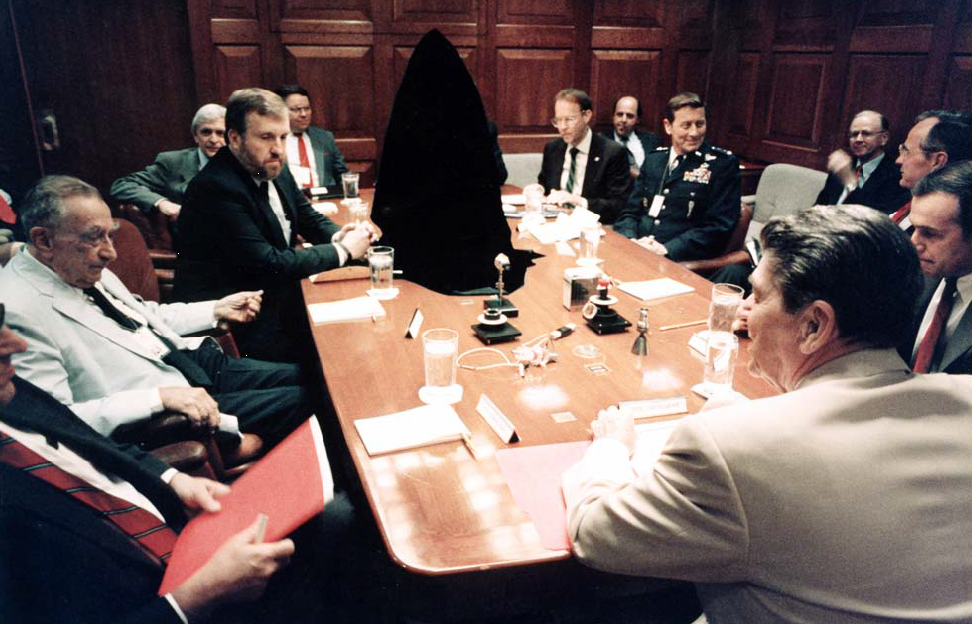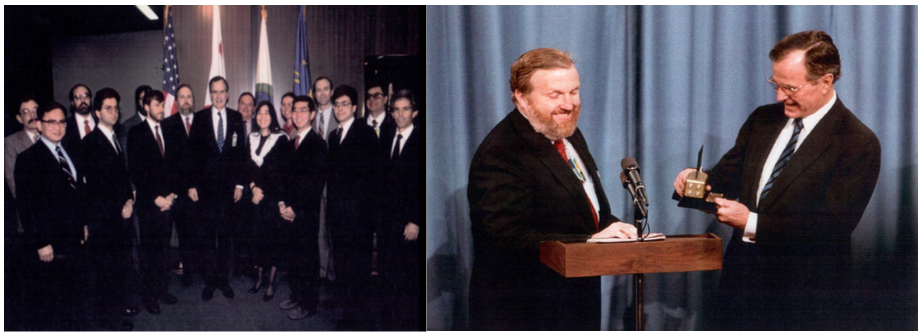Few if any of those recalling the important contributions of former President George H.W. Bush over the past few days have mentioned his memorable, at least to me, contribution to enabling the ballistic missile defense (BMD) capabilities we have today.
I was not a close colleague of the President’s, but I will always remember what I believe should rank among his most important contributions, with a still most pertinent legacy—and one that has been seldom if ever mentioned by others.
I was privileged to serve in three posts under President Reagan and Vice President Bush, finally as Chief Negotiator in our Defense and Space Talks with the Soviet Union. My primary mandate was to defend President Reagan’s Strategic Defense Initiative (SDI) efforts, which gave us enormous leverage in those Nuclear and Space Talks that produced the 1987 INF Treaty and 1991 START Treaty early in the Bush administration.
A primary SDI goal was to determine whether space-based BMD systems were feasible, and if so to set the stage for deploying them to protect the American people. Toward the end of President Reagan’s presidency, scientists and engineers at the Lawrence Livermore National Laboratory (LLNL) developed such a viable concept, a space-based interceptor system called Brilliant Pebbles.
The first SDI Director, USAF Lt. General Jim Abrahamson, initiated the next step to demonstrate that feasibility. Toward the end of the Reagan administration and early in the Bush-41 administration, the second SDI Director — USAF Lt. General George Monahan — executed a major series of critical reviews validating that view and gaining approval for a Demonstration Validation (DemVal) program involving two contractor teams to prove the concept.
Concurrently, the House and Senate Armed Services Committees proposed and the congress passed the National Defense Authorization Act of 1989—NDAA(1989), which severely cut funding needed to evaluate any and all space based interceptor (SBI) systems, including designs being considered by the Air Force — and especially LLNL’s highly classified Brilliant Pebbles concept.
Shown below is a photograph from a pivotal briefing of that concept to President Reagan. A model of the then still highly classified model of a Brilliant Pebble is under a cloak on the table immediately in front of its inventor, Dr. Lowell Wood. Among others familiar to those of that era, you will see on the right the next President, then Vice President George H.W. Bush. With his concurrence, President Reagan vetoed the NDAA(1989).
I was at the negotiating table in Geneva during these events, but had cabled many of the President’s closest advisors on the importance of fully funding the SDI space programs, particularly the Brilliant Pebble effort, because of the great negotiating leverage they provided, that already had helped produce the 1987 INF Treaty and that were supporting our aspirations for a START Treaty, finally completed in 1991.
With then Vice President Bush’s concurrence, President Reagan vetoed the NDAA(1989) — a very public fact that among other things exposed a no longer highly classified Brilliant Pebbles program that continued to progress under President Bush.
I believe the Chairmen of the House and Senate Authorization Committees never forgave this very unusual veto — and they led the dismantlement of this important program shortly after President Bush passed the baton to President Bill Clinton on January 20, 1993. But I digress.
In the early days of President Bush’s administration, I began the renewed negotiations with the Soviet Union, including at an important Ministerial in Jackson Hole, Wyoming that reasserted President Bush’s priority for continuing now his SDI program. I then passed the Geneva baton to Ambassador Dave Smith to lead Defense and Space Talks that continued to emphasize the possible future role of space-based defenses.
Shortly thereafter, President Bush issued a directive to refocus the SDI program, because congress, in anticipation of the pending end of the Cold War, was intent on severely cutting the overall Defense budget and for SDI in particular.
He and Defense Secretary Dick Cheney then asked me to lead that study, which reported out on March 30, 1990 —months before the beginning of Desert Storm in early August, when the Patriot-Scud duel captured for the public the potential importance of ballistic missile defenses.
My recommended refocusing combined BMD systems in a global architecture that included: 1) ground-based systems to protect the U.S. homeland, which we called National Missile Defense (NMD) Systems; 2) ground- and sea-based systems to protect our overseas troops, friends and allies — which we called Theater Missile Defense (TMD) systems; and 3) space-based systems that could protect against ballistic missiles launched from anywhere to attack targets almost anywhere else.
I recommended a top priority for Brilliant Pebbles to be the space-based component, and that recommendation was endorsed by President Bush. While I was conducting my review, he visited Lawrence Livermore National Laboratory and gave his historically important support to the Brilliant Pebbles space based interceptor program, which was the most important and most cost-effective initiative of the SDI era (1983-1993). The photographs below show the LLNL Brilliant Pebbles team and Dr. Lowell Wood, who invented Brilliant Pebbles, presenting a scale model to then President Bush.
Notably, today’s technology permits much greater miniaturization, so the actual size of today’s Brilliant Pebble would be more like this scale model being held by President Bush than the 1989-sized Brilliant Pebble on the table in the preceding figure.
Shortly after I concluded my March 30, 1990 study, then Defense Secretary Cheney invited me to lead as SDI Director and “make it happen.” I charged the government and contractor SDI team to use my report as the basis for achieving that objective.
Then in the following January, following his historically important Desert Storm success, President Bush officially announced his support for the refocused program, which we called Global Protection against Limited Strikes (GPALS):
“… Looking forward, I have directed the SDI program be refocused on providing protection from limited ballistic missile strikes, whatever their source. Let us pursue an SDI program that can deal with any future threat to the United States, to our forces, overseas and to our friends and allies.” ~ President George H.W. Bush, January 29, 1991.
Click here for the February 12, 1991 Pentagon press briefing given by then Assistant Secretary for International Security Policy Stephen Hadley and me, to elaborate on President Bush’s direction. Note the transcript of our briefing and our exchange with the press, describing the various system components of GPALS — land based, sea-based and space-based. Later we also added unpiloted air-based defenses to shoot down ballistic missiles in their boost phase while they rise from their launch pads.
Note for Brilliant Pebbles, the estimated cost of research, development, deployment and operations for 20 years was $10 billion in 1988 dollars — about $20 billion in today’s dollars.
That estimate was based on the best independent costing studies within the Pentagon and by the two contractor teams that won the competition between five teams to execute a Demonstration and Validation (DemVal) program fully approved by the Pentagon’s Defense Acquisition Board. And with today’s more advanced technology the cost should be less for an even more capable space based interceptor system.
During the following two years, we made very important progress on that development effort. In fact, most if not all our currently operational TMD and NMD systems trace their initial acquisition heritage to that period.
But the space-based components, particularly Brilliant Pebbles, were scuttled by the Clinton administration in early 1993, and never since have been revived.
I hope that President Trump’s advocacy for a Space Force will provide the means to revive SDI’s most cost-effective product, space based interceptors now based on today’s more advanced technology — rather than the 1989 technology that even then made Brilliant Pebbles the first SDI system to be approved to enter a formal (DemVal) program.
Based on recent reports, gaining that needed support may be an uphill battle. Click here for yesterday’s Roll Call article by Andrew Clevenger, “Trump Loves Space Force. Can He Convince Skeptical Lawmakers?” It lays out specifically some of the opposition that President Trump must overcome.
In any case, reviving and accelerating a modern Brilliant Pebbles program would properly honor President George Herbert Walker Bush’s seemingly forgotten initiative.
Bottom Lines.
As America honors President Bush for a lifetime of many important contributions, including as the Cold War was ending and during Desert Storm to free Kuwait from Saddam Hussein’s invasion — events I saw up close and personal, we should also remember President Bush for his early advocacy and support that led to our ability today to defend America and our overseas troops, allies and friends against ballistic missile attack.
We should complete the original vision he also supported, and revive a modern Brilliant Pebbles program, now employing the best of today’s technology.
What can you do?
Join us in praying for our nation, and for a rebirth of the freedom sought, achieved and passed to us by those who came before us.
Help us to spread our message to the grass roots and to encourage all “powers that be” to provide for the common defense as they are sworn to do.
Begin by passing this message to your friends and suggest they visit our webpage www.highfrontier.org, for more information. Also, please encourage your sphere of influence to sign up for our weekly e-newsletter.
Encourage them to review our past email messages, posted on www.highfrontier.org, to learn about many details related to the existential manmade and natural EMP threats and how we can protect America against them. I hope you will help us with our urgently needed efforts, which I will be discussing in future messages.
Click here to make a tax deductible gift. If you prefer to mail a check, Please send it High Frontier, 20 F Street 7th Floor, Washington, DC 20001.
E-Mail Message 181204
Please click here to read Past Weekly Updates!
Please help High Frontier continue this important and timely work!
Be sure to follow us on our Social Sites!
If you found this letter via our Social Sites, and you would like to subscribe, please click below!







